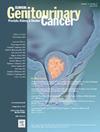Creatinine-Cystatin C Ratio as a Promising Prognostic Biomarker in Patients With UTUC After Radical Nephroureterectomy
IF 2.7
3区 医学
Q3 ONCOLOGY
引用次数: 0
Abstract
Purpose
The aim of this study was to determine the impact of the preoperative creatinine-cystatin C ratio (CCR) on the survival prognosis of patients following radical nephrectomy (RNU) for upper tract urothelial carcinoma (UTUC).
Methods
The retrospective analysis was conducted on UTUC patients who underwent radical nephrectomy (RNU) at West China Hospital between January 2009 and December 2019. The endpoint of the study was cancer-specific survival (CSS). Kaplan-Meier curves were used to estimate survival, and Cox proportional hazards modelling was used to assess risk. Nomograms were developed to predict CSS at 3 and 5 years of age, and the predictive power was assessed.
Results
A critical CCR of 59.61 µmol/mg was demonstrated to affect 504 patients with UTUC who had undergone RNU. A correlation was identified between a lower preoperative CCR and a considerably worse CSS. In patients with UTUC, CCR was identified as an independent risk factor for CSS, particularly in patients with locally advanced UTUC (pT ≥ 3) (HR: 1.84, 95% CI: 1.14, 2.97). Moreover, the CCR-based nomogram exhibited robust predictive capacity, with areas under the curve for the 3- and 5-year CSS reaching 0.823 and 0.793, respectively.
Conclusion
Preoperative CCR is an independent predictor of CSS in UTUC patients receiving RNU treatment. As such, it should be viewed as a potentially useful customized tool in therapeutic decision-making.

肌酐-胱抑素C比值作为根治性肾输尿管切除术后UTUC患者预后的生物标志物
目的:本研究的目的是确定术前肌酐-胱抑素C比值(CCR)对根治性肾切除术(RNU)上尿路上皮癌(UTUC)患者生存预后的影响。方法:回顾性分析2009年1月至2019年12月华西医院行根治性肾切除术(RNU)的UTUC患者。该研究的终点是癌症特异性生存(CSS)。Kaplan-Meier曲线用于估计生存率,Cox比例风险模型用于评估风险。采用nomogram来预测3岁和5岁时的CSS,并对预测能力进行评估。结果:504例接受RNU治疗的UTUC患者的临界CCR为59.61µmol/mg。术前较低的CCR与较差的CSS之间存在相关性。在UTUC患者中,CCR被确定为CSS的独立危险因素,特别是局部晚期UTUC患者(pT≥3)(HR: 1.84, 95% CI: 1.14, 2.97)。此外,基于ccr的nomogram预测能力较强,3年和5年CSS的曲线下面积分别达到0.823和0.793。结论:术前CCR是接受RNU治疗的UTUC患者CSS的独立预测因子。因此,它应该被视为治疗决策中潜在有用的定制工具。
本文章由计算机程序翻译,如有差异,请以英文原文为准。
求助全文
约1分钟内获得全文
求助全文
来源期刊

Clinical genitourinary cancer
医学-泌尿学与肾脏学
CiteScore
5.20
自引率
6.20%
发文量
201
审稿时长
54 days
期刊介绍:
Clinical Genitourinary Cancer is a peer-reviewed journal that publishes original articles describing various aspects of clinical and translational research in genitourinary cancers. Clinical Genitourinary Cancer is devoted to articles on detection, diagnosis, prevention, and treatment of genitourinary cancers. The main emphasis is on recent scientific developments in all areas related to genitourinary malignancies. Specific areas of interest include clinical research and mechanistic approaches; drug sensitivity and resistance; gene and antisense therapy; pathology, markers, and prognostic indicators; chemoprevention strategies; multimodality therapy; and integration of various approaches.
 求助内容:
求助内容: 应助结果提醒方式:
应助结果提醒方式:


